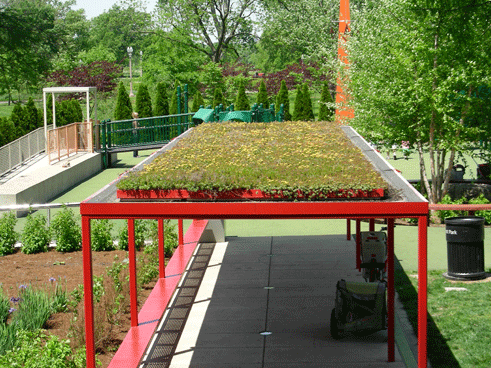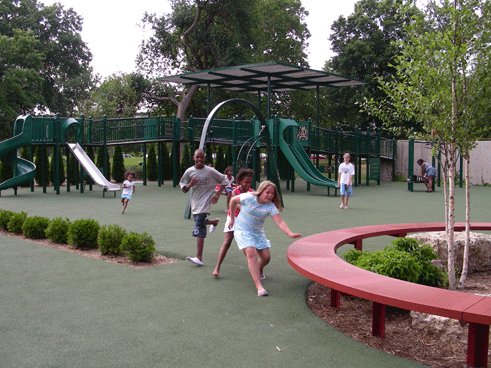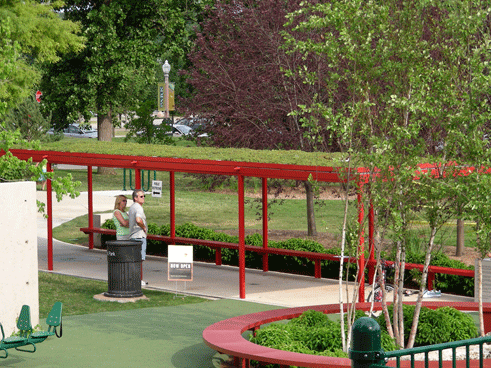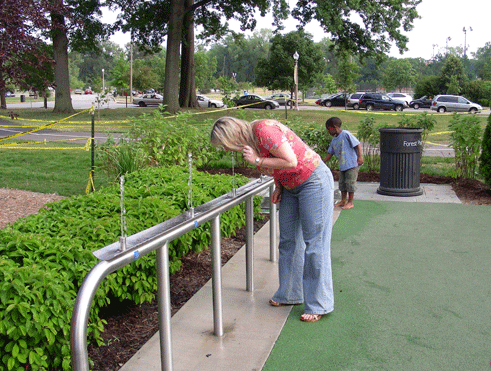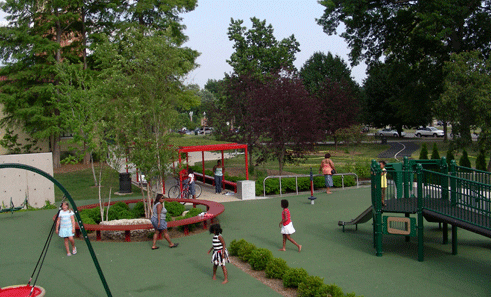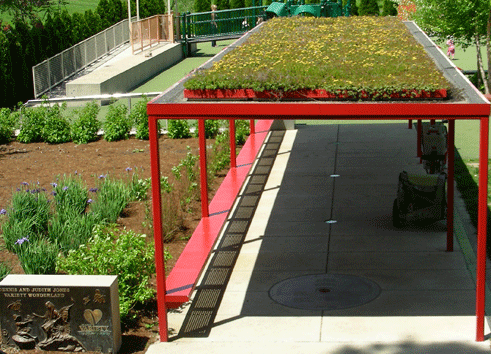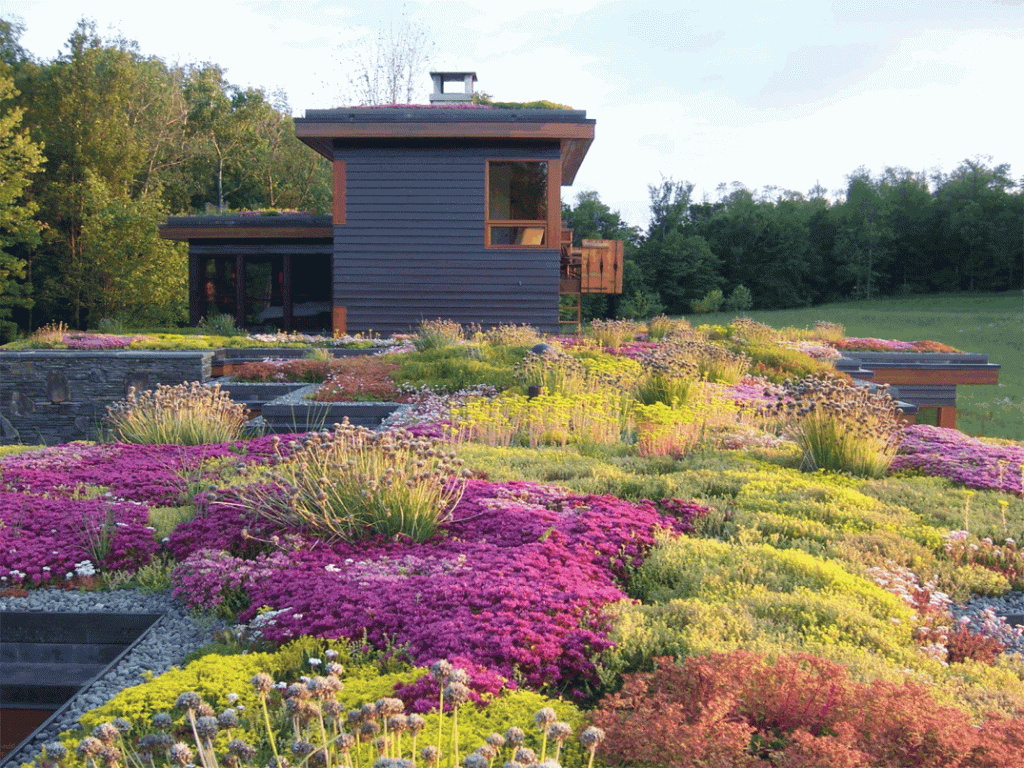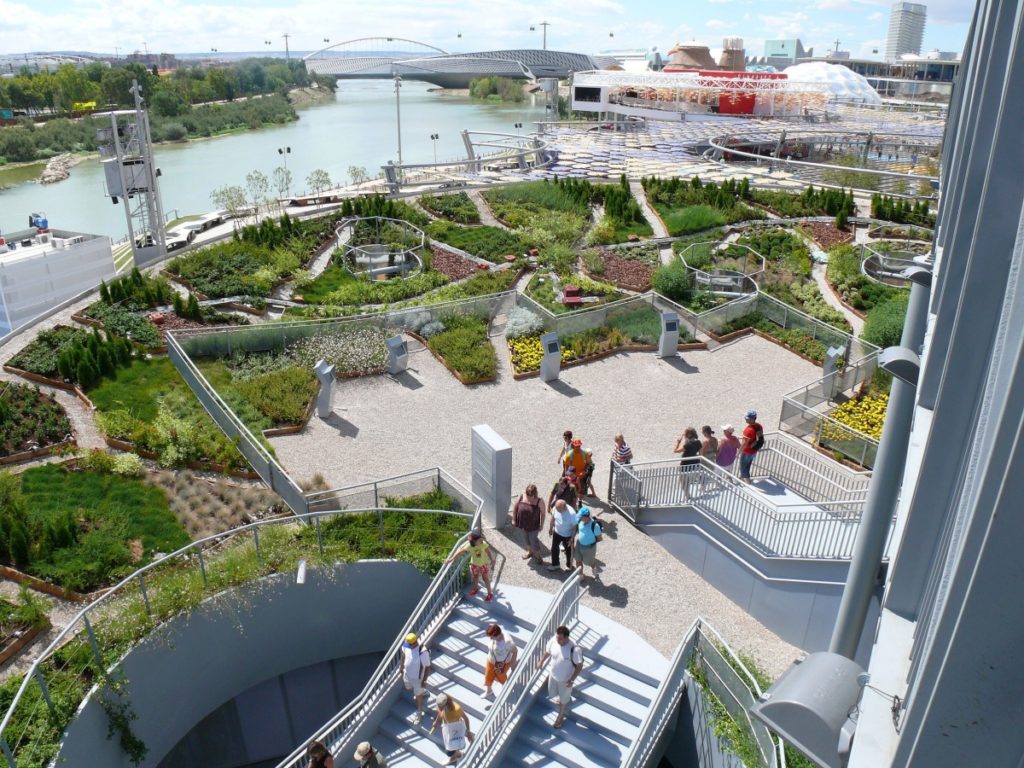Our GPW is the Dennis and Judith Jones Variety Wonderland, a delightful children’s playground in historic Forest Park, St. Louis, Missouri. One of the largest urban parks in the United States, Forest Park opened in 1876 and is the former site of The World’s Fair of 1904, drawing more than 20 million visitors from around the world. At 1,293 acres (5.2 km ²), Forest Park is over 50% larger than New York’s Central Park (843 acres or 3.41 km ²)!
Home to the region’s major cultural institutions””the Zoo, Art Museum, History Museum, Science Center and the Muny Opera, today Forest Park attracts more than 12 million visitors a year. It also serves as a sports center for all kinds of activities and the park serves as a natural oasis for the city (see a Visitor’s Guide here).

The Dennis and Judith Jones Variety Wonderland is the City of St. Louis’ first inclusive public playground. Designed in 2005 so that all children, able-bodied children and children with disabilities, could experience playtime together, it all began with feedback from a local organization: the Variety Family Council. Now Variety, the Children’s Charity of St. Louis, they couldn’t find a public playground where their children with disabilities could play with their siblings – and so a saga was born. Variety serves children with physical and mental disabilities in the region from infancy to the age of 21. Variety Week is April 17-24, 2010, and serves as a means to maximize awareness and fund-raising opportunities to benefit community children.
“We wanted this to be a place open to all children,” said Jan Albus, executive director of St. Louis Variety. “The most important thing was that it make it so children with disabilities could play right along with all other children.”
Three years, seven local donors, and a lot of hard work later, the $2 million state-of-the-art playground design includes 29 pieces of equipment on a soft, porous 10,100 sf surface. The Dennis and Judith Jones Variety Wonderland playground is divided into five sections designed according to age, physical strength and abilities.
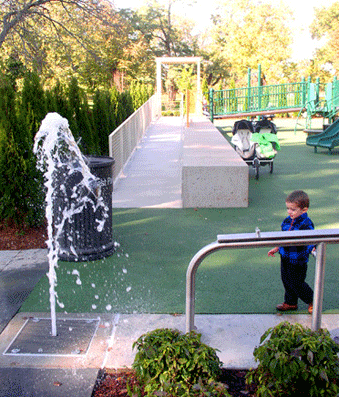 “First Adventures” is for children ages 2-5 and “Big Adventures” for children ages 6 to 12. Specialty areas are the “Observation Relaxation Deck,” “Living Shelter,” and the “Secret Garden.” The Secret Garden contains 14 colorful perennials that attract, feed and house butterflies. Learning stones will teach children about the life cycle of Monarchs here amidst the natural habitat.
“First Adventures” is for children ages 2-5 and “Big Adventures” for children ages 6 to 12. Specialty areas are the “Observation Relaxation Deck,” “Living Shelter,” and the “Secret Garden.” The Secret Garden contains 14 colorful perennials that attract, feed and house butterflies. Learning stones will teach children about the life cycle of Monarchs here amidst the natural habitat.
Constructed to ADA standards for handicap accessibility, equipment includes a slide for children with cochlear implants, Braille and clock panels for the blind, talk phones, surface fountains and 8′ high ramping so children can experience a tree house affect. You’ll also find a spyro slide, double slide, corkscrew climber, swings with bucket seats, spring pods, disc swing monkey bars with a vertical ladder, a pipe barrier with a steering wheel, and more.
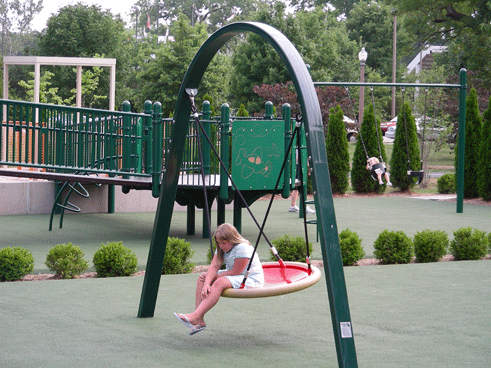
This all-inclusive playground is located adjacent to the Dennis and Judith Jones Visitor and Education Center. Formerly the Lindell Pavilion, it was built in 1892 as a shelter for streetcar passengers, and after a $4 million restoration, the facility is now home to Forest Park Forever, a not-for-profit organization dedicated to raising private funds for the restoration of Forest Park.
Kelly Luckett, LEED AP, GRP, and President of Green Roof Blocks (and one of our contributing editors, also known as “The Green Roof Guy“), was responsible for the lovely modular greenroof atop the walkway pavilion that connects from the Visitor and Education Center and greets children to the play area. I asked him how he became involved with Forest Park Forever, and he replied:
“I did a lunch and learn for Powers Bowersox Associates, a St. Louis architectural firm. After lunch, they showed me the preliminary sketches of the project and said they wanted to do a green roof on the structure so that it better fit into the green landscape of Forest Park. They liked the portability of the modular concept that allowed us to pre-grow modules so the plants were more mature for the dedication ceremony.”
The roof is constructed of 60 mil reinforced EPDM fully adhered to poly-isocyanurate over metal deck, and 76 Green Roof Blocks were grown offsite at Jost Greenhouses for approximately 10 weeks allowing the plants to mature to 80% coverage at the time of installation.
Green Roof Blocks are low-maintenance, self contained, portable units consisting of a 24″ x 24″ module fabricated of heavy gauge anodized aluminum. Walk pad material is fastened to the bottom, serving both to protect the roofing surface and to allow drainage under the Green Roof Blocks. The walk pad material used is procured from the manufacturer of the building owner’s roofing system to insure compatibility and warranty integrity.
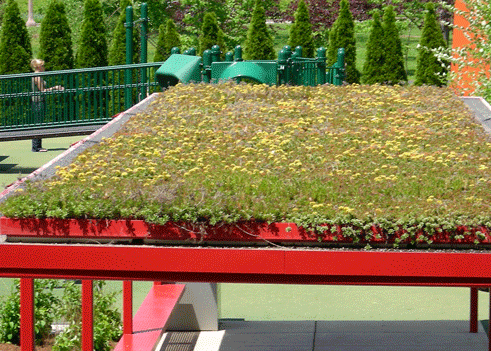
Powers Bowersox did not like the look of the sides of the aluminum modules and they requested Kelly to design a sheet metal trim piece that could be painted to match the edging of the roof, so a red metal skirt was installed at the Forest Park playground around the perimeter Blocks.
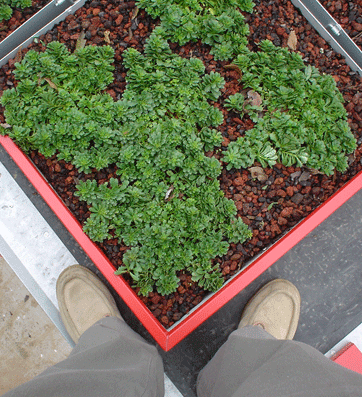 Remarkably, from a survival point of view (let alone plant diversity), the Green Roof Blocks were propagated with a single Sedum floriferum cultivar named ‘Weihenstephaner Gold,’ which performs beautifully in USDA Heat Zones 3-7. Although quite luscious in its profusion of yellow and pink-hued summer blossoms (see above in flower from last spring 2009) as well as being and very effective and successful, it was the company’s last foray into a mono-crop green roof palette. As current policy, Green Roof Blocks since uses multi-species for all projects. Kelly explains:
Remarkably, from a survival point of view (let alone plant diversity), the Green Roof Blocks were propagated with a single Sedum floriferum cultivar named ‘Weihenstephaner Gold,’ which performs beautifully in USDA Heat Zones 3-7. Although quite luscious in its profusion of yellow and pink-hued summer blossoms (see above in flower from last spring 2009) as well as being and very effective and successful, it was the company’s last foray into a mono-crop green roof palette. As current policy, Green Roof Blocks since uses multi-species for all projects. Kelly explains:
“The plant species was selected for the evergreen characteristics, though we have since moved away from single species planting strategies for our green roof projects. Only having one plant species planted on a green roof leaves the project vulnerable to weather anomalies or species specific pest that could affect the entire green roof. We now plant at least five different species within each module. This strategy establishes a diverse eco system more closely mimicking what we see in nature. The plants on this project continue to thrive in part because the green roof plants have been included in the hundreds of thousands of plants that are under the constant watchful eye of the Forest Park Forever horticulturists.”
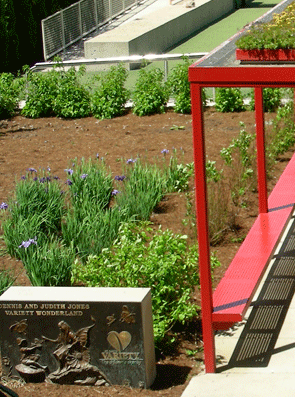 The growing media here is a 4″ deep blend of 80% red lava rock and 20% composted pine bark. The plants were initially fertilized using Scotts Osmocote with a 12 to 14 month release. Kelly says that each year since, he has picked up Vic (of Jost Greenhouses) and driven to each of their St. Louis green roof projects for maintenance and assessment.
The growing media here is a 4″ deep blend of 80% red lava rock and 20% composted pine bark. The plants were initially fertilized using Scotts Osmocote with a 12 to 14 month release. Kelly says that each year since, he has picked up Vic (of Jost Greenhouses) and driven to each of their St. Louis green roof projects for maintenance and assessment.
“We give each one the spring feeding of slow release fertilizer, the plants get inspected by the trained eye of horticulturist Vic Jost, and I get a chance to get fresh photos of another year of plant growth. We do not provide routine maintenance on our projects in other parts of the country. Our St. Louis customers find this added perk to be a nice touch,” Kelly Luckett adds.
Kelly says he is pleased that some stakeholders even make it a point to be present so they can discuss the project with Vic and himself, and looks forward to their maintenance visit each year. So for almost five years, this simple vegetated roof has not only survived with minimal maintenance, by all accounts it has flourished quite nicely.
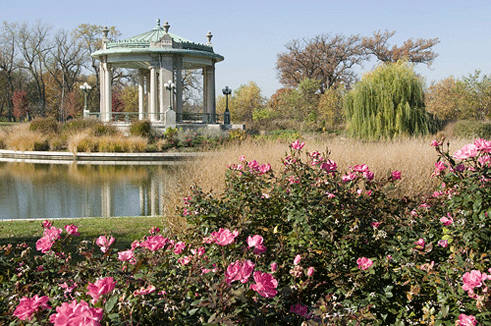
Aramis and I had the opportunity to visit the stunning Park Forest grounds and this beautiful playground in late June of 2006 when I was invited by Dr. Bill Retzlaff of Southern Illinois University-Edwardsville, IL (SIUE) and Kelly Luckett to speak at the SIUe Green Roof Symposium. By the way, Kelly is also the author of “Green Roof Construction and Maintenance” (GreenSource Books), 2009 from The McGraw-Hill Companies, Inc. – a great resource, full of detailed, useful information for all of us.
Kelly and his wife Trish played wonderful hosts to us and showed off their lovely city by highlighting the Forest Park Forever playground, where I found a very cool drinking fountain feature, above, and also taking us to many attractions – the iconic image of St. Louis – the Gateway Arch, a Cardinals baseball game, and the awesome and sometimes surreal glass-blown designs of Dale Chihuly at the Missouri Botanical Gardens “Glass in the Garden” exhibition, below.
Forest Park is really a midwestern gem – a peaceful place to relax and reflect in a lush, green space filled with water, trees and sky. As we all know, playtime is one of the strongest teachers and in such a fun and accessible environment, children will learn naturally about various forms of diversity, disability and acceptance while developing increased strength, coordination, confidence and social skills.
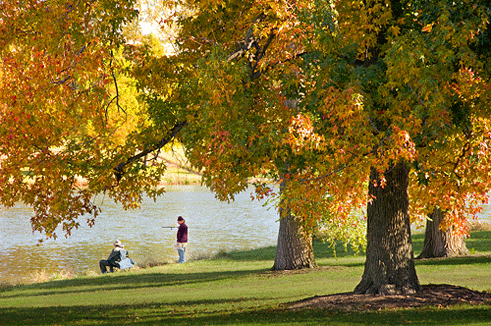
I had the pleasure of seeing kids of all ages and abilities benefit while playing in this charming and educational wonderland, and I sure had a good time, too!
An important urban oasis of green within metro St. Louis, Forest Park offers a respite for migrating birds and butterflies, and an integrated ecosystem where humans and nature interact – especially on one albeitly small playground and its simple greenroof.
~ Linda V.
 Greenroofs.comConnecting the Planet + Living Architecture
Greenroofs.comConnecting the Planet + Living Architecture
